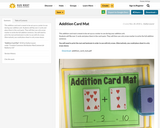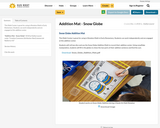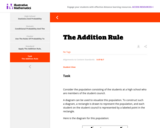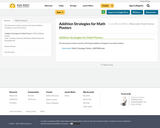
This microtutorial walks you through how to add a website or url to the Resource Bank.
- Subject:
- Education
- Educational Technology
- Material Type:
- Activity/Lab
- Author:
- Sask DLC
- Date Added:
- 04/17/2024

This microtutorial walks you through how to add a website or url to the Resource Bank.

This short video and interactive assessment activity is designed to teach fourth graders about adding and subtracting.

This short video and interactive assessment activity is designed to teach fourth graders about adding and subtracting money with pictures in columns.

This is an interactive assessment and video designed to teach Adding and Subtracting (Numbers up to 20) - Word Problems to first graders.

This short video and interactive assessment activity is designed to teach fourth graders about adding and subtracting terms (numbers to 100).

To add the vectors (x‰âپ,y‰âپ) and (x‰ââ,y‰ââ), we add the corresponding components from each vector: (x‰âپ+x‰ââ,y‰âپ+y‰ââ). Here's a concrete example: the sum of (2,4) and (1,5) is (2+1,4+5), which is (3,9). There's also a nice graphical way to add vectors, and the two ways will always result in the same vector.‰غـ‰غـ

This addition card mat is meant to be set up as a center to use during your addition unit.
Students will flip over 2 cards and place them in the card spots. They will then use a dry erase marker to write the full addition sentence.
You will need to print the mat and laminate in order to use with dry erase. Alternatively, you could place sheet in a dry erase sleeve.

This short video and interactive assessment activity is designed to teach fourth graders about addition: completing the addition sentence.

This Math Center is great for using in Rotation Math in Early Elementary. Students can work independently and are engaged at this addition center.

The purpose of this task is to study some patterns in a small addition table. Each pattern identified persists for a larger table and if more time is available for this activity students should be encouraged to explore these patterns in larger tables.

This is a task from the Illustrative Mathematics website that is one part of a complete illustration of the standard to which it is aligned. Each task has at least one solution and some commentary that addresses important aspects of the task and its potential use.

This document contains 6 posters full of good addition strategies to use with students.

This document is the planning template for Triads when examining student programming and classroom supports.

Students place markers on the numbers 2-12. Students toss two 6-sided dice, find the sum and remove a marker from that number, if there is still one. The first player to remove all markers wins the game. This game can be used as addition practice or as an introduction to the probability of the different outcomes of rolling two dice. This game was developed by a Monmouth University student for the Probability Fair. These games help students acquire proficiency in addition and subtraction facts.

Learn addition and subtraction.

This short video and interactive assessment activity is designed to teach third graders about one step addition and subtraction - word problems.

This short video and interactive assessment activity is designed to teach fourth graders about one step metric capacity with addition and subtraction - word problems.

This short video and interactive assessment activity is designed to teach fourth graders about addition of capacities - word problems.

This short video and interactive assessment activity is designed to teach third graders about addition of sequential capacities - word problems.

The first in a two-part series, this Module discusses problem behavior in terms of the stages of the acting-out cycle and suggests ways to respond to students in the cycle's different phases (est. completion time: 1 hour). When you have completed this Module, be sure to learn more in part two.